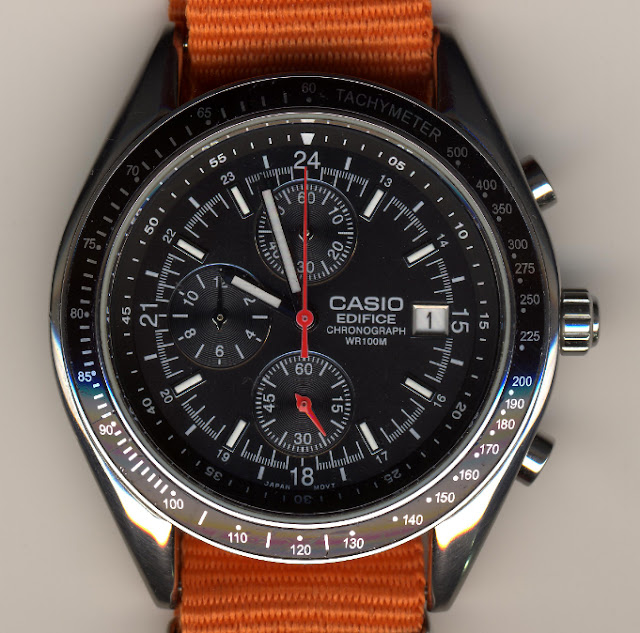This is actually my first Swiss watch: an Omikron winder from 60's-70's, powered by Unitas 6325 movement. It's in desperate need of a proper servicing, since it can run for only 10hrs on a full winding (this movement has a very long mainspring and its normal power reserve is 47 hrs).
Visible traces of mechanical damage
Hour and minute hands on this watch are not OEM: it seems that they've been custom crafted from a kind of brass-like alloy with a pinkish hue. Shape of new hands doesn't follow the original pattern and lume is missing altogether. Way back, this watch has probably suffered a severe blow (or even been stepped on) causing the glass to be smashed, damaging the hands and leaving permanent scratches on the dial, all this prompting a subsequent overhaul. Winding crown has been replaced with a generic spare part and acrylic is showing a crack on 4 o'clock. Watch case has developed corrosion pitting wherever the chrome plating has been damaged, showing the base metal - a kind of dark greyish (zinc?) alloy instead of brass/bronze which was commonly used in watches of this price tag. According to some local collectors, Omikron watches are notorious for their decomposing alloy cases. Bezel ring is made of brass, which is visible under the chrome plating at some damaged spots.

This 21-jewel movement looks quite elegant in its chrome/brass combo, although surface finishing is still in economy class. All 17-jewel Omikron versions of Unitas 6325 that I've seen have a full-chrome finish. There are some sharp edges and visible burrs on the inside of the lugs (poor craftsmanship!) Serial No. is stamped on case back.
Inscription "T SWISS MADE T" at the bottom of the dial denotes Tritium lume markers and the country of origin. Lume is almost non-existent on this unit due to damage. Although Unitas movement is without doubt a Swiss product, Omikron of that era was a quite elusive company with rather opportunistic product range (AFAIK they've also branded produce scales, office calculators and what not).
To my knowledge this brand has gained some popularity in Europe during the 70's for selling quite sturdy, reliable, moderately priced watches and of course for being labelled "Swiss made". This was especially the case with the fmr. West Germany's "gastarbeiter" working class population from the Balkans, who brought amounts of Omikrons and Darwils to their home countries with them, so these watches could be (like highly praised Mercedes and Volkswagen cars) quite often found all over the region.
Close-up of sturdy but neglected machinery in need of proper servicing. Although movement is branded Omikron, "UT" logo and number "6325" inscribed underneath it (far left, partially visible) denote the Unitas S.A. ébauche factory and movement caliber respectively.
Both original 6325 and 1130 movements are true workhorses and they're sometimes referred to as "Wehrmachtswerk", which is mainly a marketing gimmick aimed at associating them with build quality, sturdiness and reliability of a German military engineering. In fact this name pertains to entire group of mechanical wrist watch movements sized 13 lignes (13''' ~ approx. 30mm) which emerged during the period between the two World Wars and into the WW2, not having any direct connection with German armed forces but being recognized by the military as having potential for both accuracy and robustness due to their bigger than usual size. To my knowledge there were no "official army issue" watches in the Wehrmacht, although some chosen watch models were procured in small-ish numbers by the military on separate contracts from prominent Swiss and German watch manufacturers.






















